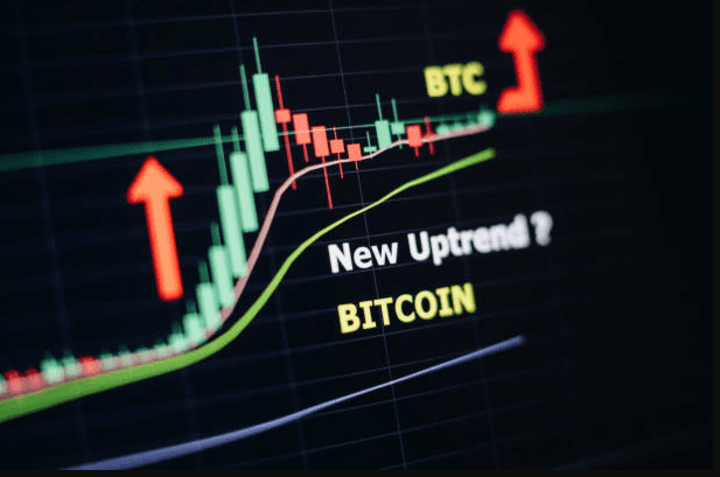Cryptocurrency is one of the top topics in finance and business all over the world. Bitcoin, the first and largest cryptocurrency launched in 2009, still dominates the crypto market. With a market capitalization of over $590 billion, Bitcoin continues to pave the way for the entire crypto market.
Since its inception, Bitcoin has undoubtedly had a wild ride, from $0.0009 to over $67,000 in 2021. Now, the question on the mind of everyone is the direction of Bitcoin’s wild ride ahead: To the moon or bust?
This guide will explore key aspects of Bitcoin, macro fundamentals propelling Bitcoin, adoption trends, price catalysts, and future price predictions.
Overview of Bitcoin
Bitcoin greatly influences the crypto market as it pioneered the entire cryptocurrency operation. It was launched in 2009 after an anonymous individual/ group named “Satoshi Nakamoto” released the Bitcoin whitepaper. This was in the wake of the aftermath of the 2007-2008 crises. The whitepaper released in 2008 revealed the use of blockchain technology to revolutionize the finance industry. By 2013, Forbes named Bitcoin as the year’s best investment.
Bitcoin runs a decentralized blockchain network and aims to enable peer-to-peer digital payments outside of traditional finance. The concept of blockchain technology implies that transactions are recorded on a distributed ledger, which facilitates transparency and security. This decentralized approach to digital money eliminates the need for control or approval by financial institutions. Therefore, users can use BTC across borders without limitations from traditional financial institutions.
Bitcoin went through a massive bull run in 2017, which captured the attention of mainstream media and investors all over the world. The market value of BTC reached its first all-time high, surging over $2,000 within the year. This meteoric rise sparked excitement among cryptocurrency community members and non-members alike.

However, Bitcoin experienced a downtrend as the price declined over 80% from its peak. This was the first real-life lesson in volatility for BTC investors. Regardless, Bitcoin’s legacy as a pioneer crypto asset remains without a doubt, and its influence continues to shape the future of the crypto industry.
After the 2020 global pandemic that significantly affected businesses and economies, positive sentiments toward the crypto market increased. This was attributed to economic uncertainty and growing acceptance by big businesses. Tesla, Square, and Microstrategy announced investments in Bitcoin, boosting cryptocurrency's mainstream recognition and legitimacy. As a result, the price of BTC soared to over $67,000 in November 2021.
Macro-fundamentals Propelling Bitcoin
Over the years, Bitcoin has experienced significant growth driven by various macroeconomic factors. Getting familiar with these concepts is critical to understanding the position of BTC as a highly-sought after store of value. Factors like easy monetary policy, political and economic stability, and limited supply play significant roles in the rise of BTC’s market value.
Let us take a closer look at these factors:
i. Easy monetary policy and central bank stimulus
Easy monetary policy is a central bank policy that attempts to trigger the influx of cash into the banking system. This policy aims to stimulate economic growth by increasing the supply of money and reducing interest rates. While this policy has a positive outlook theoretically, it can cause inflation. This is because, with the interest rate at a low rate, individuals and businesses may borrow excessively, which increases demand and causes unreasonable inflation. As a result of the increased supply of money, the value of traditional fiat currencies could crash.
Easy monetary policies implemented by central banks have fuelled fears regarding potential inflation. The policy implies that government will inject large amounts of money into the economy. However, investors are concerned about the corrosion of purchasing power and the long-term value of traditional currencies.
In response to inflation fears, investors and individuals have turned to digital assets as an alternative to storing wealth. Additionally, the centralized nature of traditional fiat currencies is often a cause of concern. Therefore, cryptocurrencies like Bitcoin are gaining increasing positive sentiments due to their decentralized nature. This is because they are not subject to control from the government or central financial institutions, which provides a sense of security in times of uncertainty.
Central bank stimulus increases liquidity, which provides individuals with more funds to invest. Therefore, there is an increased interest in alternative assets like Bitcoin for those seeking a higher return on their investment.
ii. Political and economic instability
Political instability, such as wars or social unrest, could reduce people’s confidence in traditional financial systems. Therefore, they seek alternative assets that can provide stability and hedge against the economic impact of political instability. Bitcoin, a decentralized currency free from central authority, has become a suitable alternative for those seeking a reliable store of value in times of uncertainty.
Economic instability is often characterized by financial crises ranging from hyperinflation to currency devaluation. This situation has driven the demand for an alternative store of wealth. Bitcoin’s decentralized system, combined with its previous performance and reputation, makes it an excellent option to hedge against economic instability.
Gold has been regarded as a trusted store of value for over three thousand years. Bitcoin is dubbed “digital gold” because it has a low correlation with other assets, which makes it suitable for hedging inflation and storing value. Gold and Bitcoin are similar as they both exhibit scarcity and are not controlled by a central body. They have distinct features, as gold may be difficult and risky to acquire. On the other hand, you can easily buy, store, or sell Bitcoins from anywhere in the world. Therefore, global political and economic instability has driven demand for "digital gold" as a store of value.
iii. Bitcoin's digital scarcity and technological benefits
Scarcity is a defining feature of BTC, resembling gold scarcity. The supply of Bitcoin is capped at 21 million. Bitcoin halving, an event that occurs once in four years, also limits the supply of BTC. This event reduces the reward for mining Bitcoin by half, which is an efficient way to reduce the influx of new BTC into the crypto market.
The scarcity of Bitcoin contributes to its value. According to the dynamics of demand and supply in economics, increasing demand could trigger a price uptrend. This is quite similar to the gold market, where the scarcity makes it a high-value asset.
However, BTC's technological advantages and liquidity set it apart from gold. Bitcoin operates on a decentralized network that allows transactions across geographic boundaries, providing easy accessibility.
In addition, transactions with BTC are faster, cheaper, and more secure than physical gold or traditional banking systems. The widespread adoption of Bitcoin has increased its liquidity- the ease of buying and selling. BTC’s high liquidity makes it an excellent alternative for investment.
Adoption Trends Fueling Long-term Growth
The growth of Bitcoin is significantly influenced by adoption. Therefore, it is essential to understand these adoption trends and their impact on the long-term growth of BTC. This section will focus on adoption by institutional investors, mainstream payment platforms, and regulatory developments.
a. Institutional investors
Big investors like Grayscale, MicroStrategy, and MassMutual are buying significant amounts of Bitcoin. Grayscale Investments, a globally renowned digital asset investment fund, is at the forefront of institutional BTC adoption. The company owns about 3% of the total supply of BTC. Grayscale Bitcoin Trust enables investors to gain exposure to BTC in the form of security while avoiding the challenges of buying, storing, and safekeeping BTC directly.
Microstrategy has become BTC's largest public corporation holder, as it holds about 0.726% of its total supply. Michael Saylor, the CEO of Microstrategy, has always been vocal about BTC's potential as a long-term value store. The recent acquisition of 12,333 Bitcoin (BTC) for $347 million has sparked interest in the financial world. It has established Microstrategy as a leading institutional holder.
MassMutual, a leading life insurance company about 172 years old, made a significant move by purchasing BTC worth $100 million in 2020. The Massachusetts-based insurance company recognized BTC as a viable asset class, which was marked by a shift in sentiment among other traditional financial institutions.
The adoption of BTC by institutional investors gives it credibility as a legitimate investment. In addition, large-scale purchases of BTC increase liquidity and market stability. Increased liquidity allows for seamless trading, which makes BTC an appealing alternative for investors.
b. Mainstream payment platform
The adoption of BTC by mainstream payment platforms like PayPal, Square, and others has facilitated convenient buying and spending of Bitcoin by millions of people across the globe. A leading global online payment solution, PayPal has adopted BTC by allowing users to buy, sell, or hold BTC and other cryptocurrencies. This was a significant milestone in the adoption of BTC as PayPal’s millions of users now had easy access to cryptocurrency. Therefore, PayPal has made crypto transactions more user-friendly and accessible.
Square, another leading financial company played a key role in the adoption of BTC through its Cash App. The Cash App allows users from anywhere in the world to buy or sell Bitcoin. Therefore, the integration of BTC into its payment platform has fostered acceptance by a wider audience, especially those with limited exposure to Bitcoin.
Other payment platforms like Coinify, CoinGate, BitPay, Electroneum, Coinbase Commerce, and many others have integrated Bitcoin into their platform. They allow businesses or individuals to accept Bitcoin as a means of payment. Therefore, these platforms are critical in expanding BTC’s use case as they open new opportunities for people to interact with cryptocurrencies.
The adoption of BTC by mainstream payment platforms increases accessibility. It reduces barriers to entry, which promotes the wider adoption of digital currency. Another significant advantage is increasing mainstream exposure to millions of users. This often to leads to increased interest and use, which could trigger a price increase.
Furthermore, adoption by mainstream payment platforms increases the trust and credibility of Bitcoin transactions. These platforms have millions of users because they have earned their trust, which provides reassurance to those who may be skeptical about Bitcoin. As a result, more investors develop positive sentiments towards BTC, which could drive demand and price.
c. Regulatory clarity
Another factor contributing to the growth of BTC is regulatory clarity. Regulatory clarity is emerging, with Bitcoin now classified as an asset or commodity rather than security in key jurisdictions. This acknowledges its decentralized nature and potential to be used as a store of value. Clarity regarding the classification of Bitcoin helps to reduce skepticism surrounding the digital currency.
In addition, it promotes investors' confidence and interaction with the Bitcoin network. More so, regulatory clarity can promote global standardization across various jurisdictions. As more countries establish defining rules, it becomes easier for businesses to thrive within the Bitcoin system. Therefore, it could promote international investment in BTC, which contributes to the expansion of its ecosystem.
Price Catalysts
Bitcoin has experienced significant price fluctuations over the years. Here are some factors that act as catalysts for the price of BTC:
i. "Halving" events
Bitcoin halving is a significant event that occurs once in four years. The concept includes halving the rewards for miners- they often earn tokens for adding new blocks to the blockchain. The halving events are deliberate attempts to control the influx of new BTC. Therefore, halving events can lead to increased demand, which could trigger an uptrend in BTC’s market value.
Bitcoin has undergone three halving events in 2013, 2016, and 2020, with the next one scheduled for 2024. Halving is a critical event because it acts as a catalyst for the price of BTC. After the first halving event in 2012, the value of Bitcoin experienced an over 80 times surge, going from $12 to almost $1000. The price of BTC reached a new all-time high in 2017 after the halving event in 2016. Similarly, after the halving event in 2020, the price of BTC experienced an exponential rise reaching its all-time high of over $60,000 from about $8,000 in 2020. Therefore, halving triggers a sense of urgency among investors as they increase their purchasing power in anticipation of a price increase.
Halving events have historically triggered bull runs by reducing the supply of BTC. Economic experts consider halving events a good model as it reduces inflationary pressure on BTC, which helps increase its value.
ii. Bitcoin ETF approval

One of the most anticipated catalysts for the growth of BTC is the approval of a Bitcoin exchange-traded fund (ETF). An ETF is an investment vehicle allowing investors to gain exposure to Bitcoin without owning the asset. The Bitcoin ETF would be available on regulated stock exchanges, which increases its accessibility to a broad range of investors.
Bitcoin ETFs have been one of the hottest topics within the crypto community for a few years. However, it is already available in some countries like Dubai, Canada, and Brazil. The SEC has received applications for Bitcoin ETF from organizations like BlackRock, Valkyrie Investment, Galaxy Digital, etc. Still, it is yet to be convinced it is a reasonable investment vehicle. Regardless of the skepticism by SEC, crypto enthusiasts are optimistic about a positive announcement.
Bitcoin ETF could expose crypto to trillions in new capital through traditional investment vehicles. This option is convenient because users do not need to open accounts with exchanges. An ETF allows for portfolio diversification, which is crucial to protect profit. On the other hand, ETF has limited trading hours, and fluctuation in the price of BTC may not be reflected in the value of ETF in real time.
The approval of Bitcoin ETF provides a familiar and regulated way for traditional investors to get exposure to BTC. It would also serve as a bridge between the crypto industry and the traditional finance space. As a result, it promotes adoption and integration as BTC receives mainstream attention and acceptance.
iii. More institutional adoption
Increasing institutional adoption may follow first movers and allocate a portion of their portfolio to Bitcoin as a hedge. Institutions like Grayscale have paved the way for the adoption of BTC by finance companies as a hedge against inflation. There will be an increase in demand as more institutions adopt BTC.
Additionally, institutional adoption attracts a wider range of investors, which facilitates the growth of the Bitcoin network. More so, with more institutions adopting BTC as a hedge against inflation, its position as a reliable investment asset is solidified.
Therefore, monitoring institutional adoption is critical to identify potential price movement and BTC's future value.
Price Prediction

The crypto market is highly volatile and influenced by various factors that act as price catalysts. However, investors often desire to identify potential future trends to make informed investment decisions. Any prediction remains a probability, and investors should combine other factors before making long-term trading goals.
❖ Current trend:
Currently, the price of BTC is range-bound between $27,000 to $30,000. Therefore, it is critical to identify support and resistance zones as they can inform your trading choice. Within this range, the support zone is around $27,000, a level where the buying pressure increases to prevent further price downtrends. However, a significant resistance prevents a sustained breakout above the upper boundary of the range.
The year 2024 holds a positive outlook for BTC as some developments could act as a catalyst for its price. The US Federal Reserve is set to reduce interest rates, regulatory clarity, and the halving effect could trigger increased demand for Bitcoin.
❖ 2025 year-end target:
For the year 2025, we predict the price of BTC to be around $50,000 to $70,000. However, this is largely dependent on the impact of events such as the halving event, economic stimulus, and ETH approval. These events will stabilize the price of BTC in 2024 and provide a launching pad for price increases.
Remember, these events are supposed to facilitate mainstream attention and positive sentiment. Therefore, their impact will depend on how investors respond to these changes. Investors must closely monitor these developments and make necessary adjustments as unforeseen circumstances may affect the market dynamics.
❖ 2030 forecast:
By 2030, BTC is estimated to have exceeded its previous all-time high to reach about $300,000 to $500,000. With successful mainstream adoption on traditional financial platforms, the price of BTC should have achieved stability before 2030. More partnerships and integration of BTC by various sectors could increase demand coupled with limited supply to cause a steady price uptrend.
However, there may be risks associated with regulation or technological competition, which could affect mainstream interest and adoption. New digital assets with innovative features could challenge Bitcoin’s position as a top player in the industry. Likewise, unfavorable regulations could trigger selling pressure, which will have negative effects on the price of BTC.
Conclusion
Bitcoin is the oldest and dominant digital asset in the crypto industry. However, it is marked by extreme volatility. Easy monetary policy, political instability, and scarcity are macro fundamentals propelling the growth of Bitcoin’s network.
Adoption trends have a significant influence on BTC’s price direction. Institutional investors like Grayscale have acquired large amounts of BTC, which fuels the legitimacy of its use. Likewise, payment platforms like PayPal have made it easier for millions of individuals to use Bitcoin.
Factors like the halving event, regulatory clarity, and increased institutional adoption could act as catalysts for the price of BTC. However, risk tolerance, available capital, and investment goals should be considered before risking your money. Therefore, it is necessary to consult experts like VSTAR to get insights into your situation.
Vstar is a reliable broker that provides institutional-level trading experience, including the lowest trading cost, which means tight spread and lightning-fast execution. We also offer a demo account for beginners to practice trading strategies to mitigate loss during actual trading. VSTAR provides 24/7 customer support services as well as educational resources for our esteemed clients.





